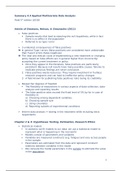Samenvatting
Samenvatting 4.4C Applied Multivariate Data Analysis (Engels)
- Instelling
- Erasmus Universiteit Rotterdam (EUR)
Deze samenvatting is gebaseerd op de hoofdstukken 2, 3, 6, 8, 9, 11, 12, 13, 14, 15 en 16 (alle verplichte hoofdstukken) van de 5e editie van Field (2018). Daarnaast zijn ook aantekeningen van colleges en opdrachten verwerkt in de samenvatting, waardoor je in één bestand een volledige overzicht h...
[Meer zien]





